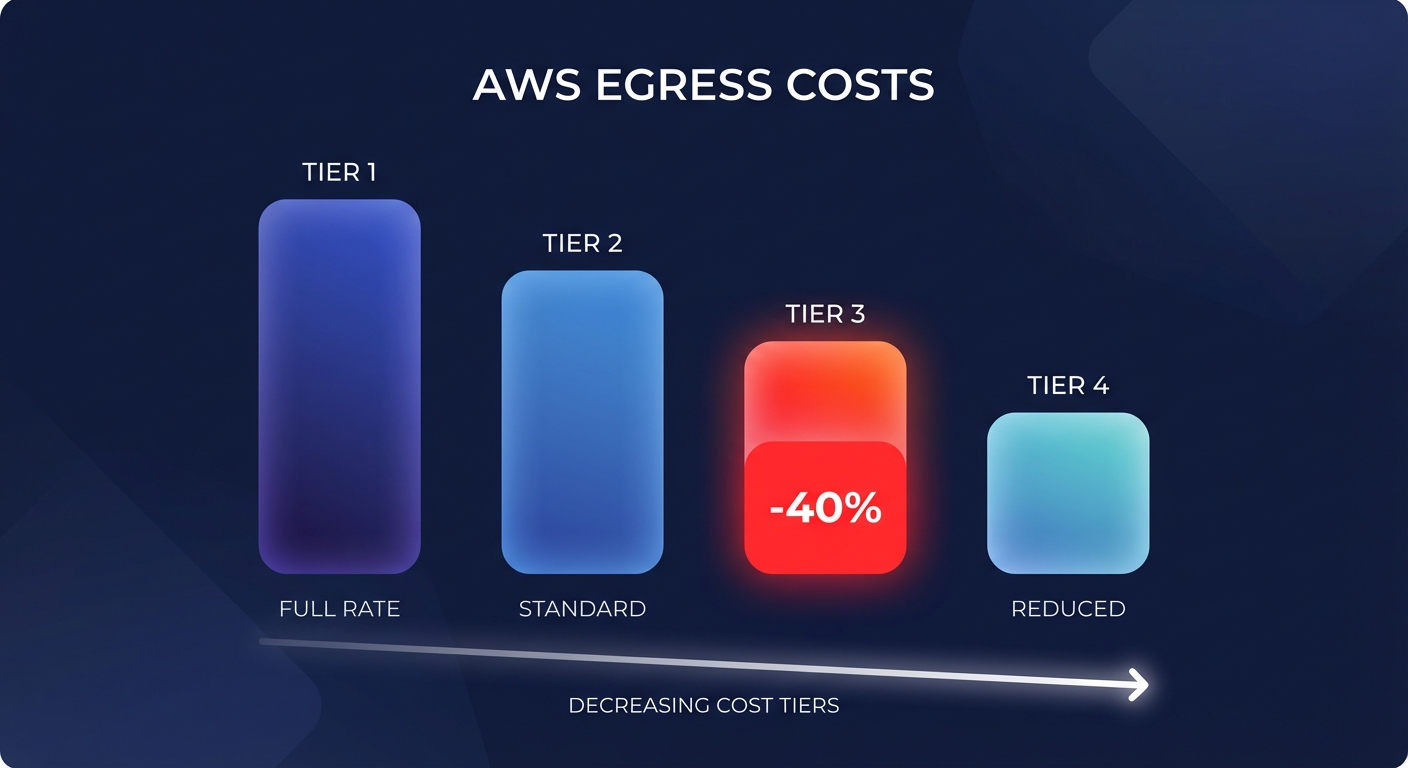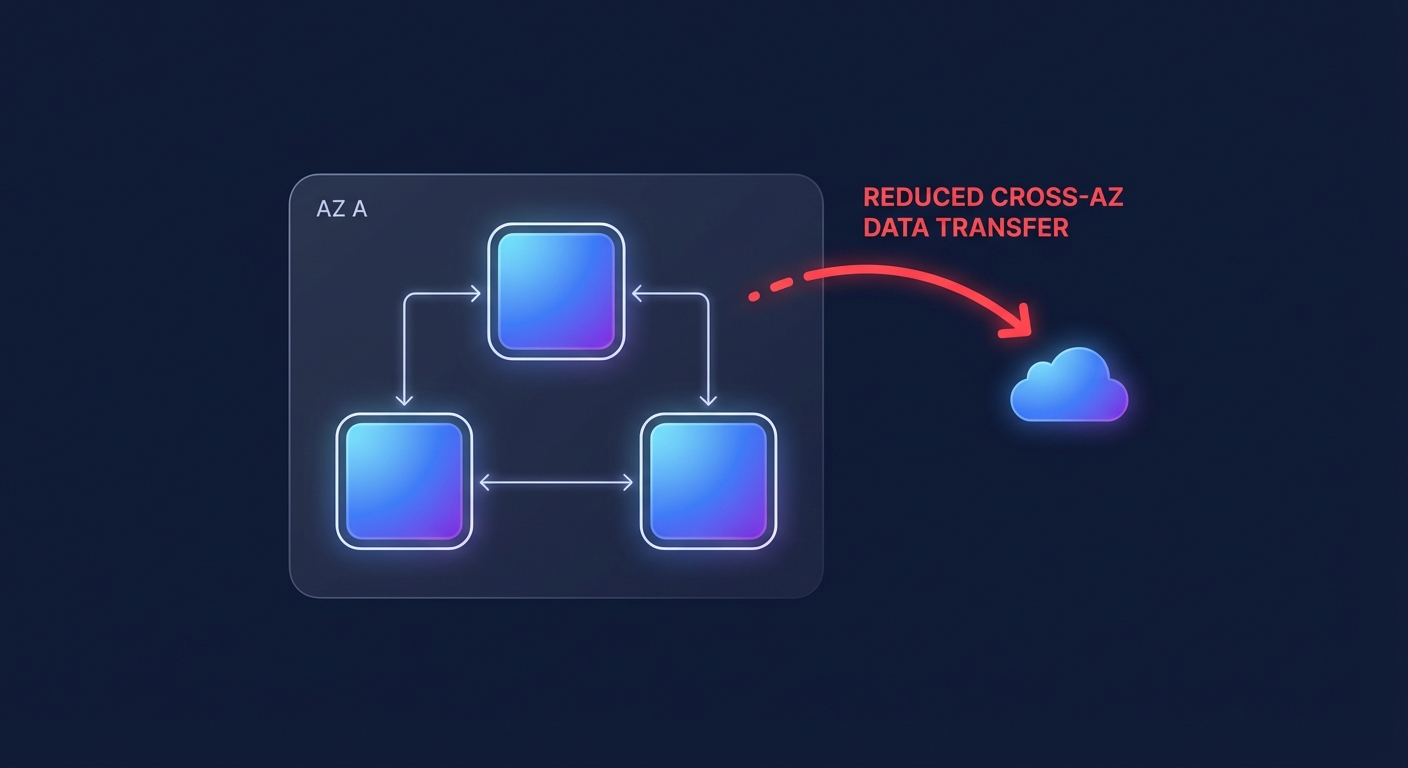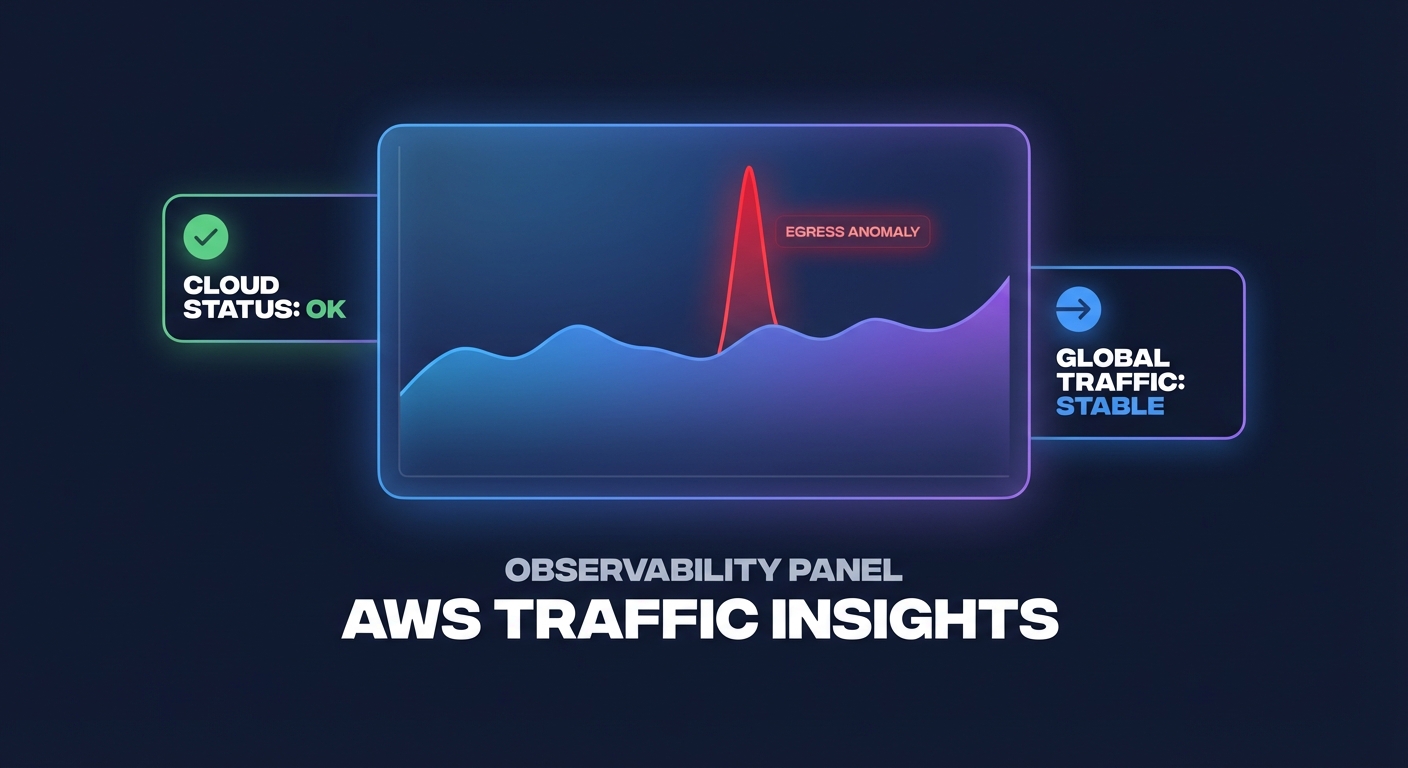AWS egress costs explained: How to monitor and reduce data transfer spend by 40%
Data transfer costs can silently devour your AWS budget. A financial services platform handling real-time feeds might see egress charges spike from $900 to $4,300 in a single quarter – despite stable user growth – simply because cross-region traffic patterns shifted. For many engineering teams, egress represents 25-35% of their total cloud bill, yet it remains one of the most poorly understood line items.
AWS egress charges apply whenever data leaves your infrastructure: crossing availability zones, moving between regions, or flowing to the internet. The pricing model is deliberately complex, with different rates for every direction data travels. But once you understand the mechanics and architectural patterns that drive egress, you can cut these costs dramatically – often by 40% or more – without compromising performance or user experience.

How AWS egress pricing works
AWS employs a tiered pricing model for internet egress where per-GB costs decrease as total monthly data transfer volumes increase. The first 100 GB per month is free (aggregated across all AWS services and regions, excluding China and GovCloud), but after that threshold you start paying. For US East (N. Virginia), the tiers break down like this: the next 9.9 TB costs $0.09/GB, the following 40 TB drops to $0.085/GB, then 100 TB at $0.07/GB, and anything over 150 TB falls to $0.05/GB. Organizations with massive data transfer volumes benefit from these declining rates, but the initial tiers still add up fast for mid-sized workloads.
Geographic variations compound the complexity. AWS charges $0.09/GB for data transfers out in most US Regions, $0.12/GB in Asia Pacific, and $0.154/GB in Cape Town, making regional architecture decisions critical for global applications. Cross-region data transfer typically costs $0.02/GB for most common region pairs, though adjacent US regions like US East (N. Virginia) to US East (Ohio) drop to $0.01/GB. Even within a single region, cross-availability zone transfers incur $0.01/GB charges in each direction, while data transfer within the same AZ using private IP addresses remains free.
S3 egress pricing follows similar tiers but with service-specific nuances: the first 10 TB per month costs $0.09/GB, the next 40 TB drops to $0.085/GB, then 100 TB at $0.07/GB, and over 150 TB at $0.05/GB. US customers also pay $0.02/GB for transferring data from S3 to a different AWS availability zone.
Hidden egress charges that inflate your bill
Cross-AZ traffic is the most insidious hidden cost. AWS’s pricing structure naturally encourages resource co-location within single availability zones to minimize these transfer costs, yet many teams default to multi-AZ deployments for high availability without calculating the egress implications. When your application servers in one AZ constantly query a database in another, those $0.01/GB charges accumulate fast – especially for high-throughput microservices architectures.
API response payloads create another blind spot. Financial platforms serving real-time market data, regulatory reports, and interactive dashboards generate enormous egress volumes with every client request. For trading platforms, egress costs often represent 25-35% of the total cloud bill due to continuous feeds pushing data to clients, even when the actual compute and storage footprint is modest.
Redundant data exports compound these costs. Development teams frequently pull production datasets into staging environments for testing, transfer logs to external analytics platforms, or replicate data across regions “just in case.” Each of these patterns triggers egress charges that serve minimal business value but accumulate month after month.
Multi-region architectures amplify every egress pattern. Organizations naturally keep databases, compute resources, and applications within the same AWS region to minimize cross-region transfer costs, but global user bases often require data closer to end users. Balancing latency requirements against egress economics becomes a constant architectural tension.
Architectural patterns to minimize egress costs
Co-locating resources in the same availability zone eliminates the most common egress charges. When your web servers, application servers, and databases all operate within a single AZ, internal traffic flows freely without triggering cross-AZ fees. AWS offers robust intra-region networking with high throughput, making single-AZ deployments viable for many workloads where the availability trade-offs are acceptable.
Implementing CloudFront early in your architecture dramatically reduces internet egress costs. For businesses transferring 0.5-2 TB monthly, using a CDN early and optimizing API payloads can significantly reduce egress costs by caching static assets and frequently accessed API responses at edge locations. Users receive faster responses while your origin servers handle a fraction of the outbound bandwidth.

Optimizing API payload sizes cuts egress volumes directly. If your API returns 500 KB of JSON when clients only need 50 KB of data, you’re paying 10x more in egress than necessary. Implementing field-level filtering, pagination, and compression can reduce response sizes by 70-90% without changing functionality. This approach is particularly effective for mobile applications where bandwidth constraints already encourage lean payloads.
Regional pricing differences can further reduce costs when latency and compliance allow; some regions price instances 5-15% lower than others, though choosing the most cost-effective region requires balancing pricing against latency, compliance requirements, and data transfer costs. For workloads serving primarily US customers, selecting a lower-cost region can yield immediate savings on both compute and egress.
Financial and trading platforms need specialized patterns. Isolating feeds and reducing redundant exports helps by ensuring market data flows to clients through optimized channels rather than generating duplicate streams for each service. Implementing a message bus architecture allows multiple internal consumers to share a single data feed, reducing external egress while maintaining real-time performance.
Monitoring egress costs in AWS
AWS Cost Explorer provides the foundation for egress visibility. You can filter by up to 18 dimensions including services, availability zones, regions, and resource IDs to identify which components generate the most data transfer costs. The tool produces three-month usage and cost forecasts and supports custom reports with hourly data for the past 14 days. However, Cost Explorer’s data refreshes only once every 24 hours, meaning you’re always looking at yesterday’s spending patterns rather than catching anomalies in real time.
AWS Cost and Usage Reports (CUR) deliver the granular detail needed for serious egress analysis. These reports break down every data transfer charge with resource-level precision, showing exactly which EC2 instances, S3 buckets, or load balancers generated egress costs and in which direction data flowed. Exporting CUR data to S3 and querying it with Athena enables custom analytics that surface patterns Cost Explorer might miss – like identifying that 80% of your cross-region traffic stems from a single microservice.
AWS Budgets and Cost Anomaly Detection add proactive alerting layers. You can configure budgets with progressive thresholds (50%, 75%, 90%, 100% of expected spend) and route notifications through SNS to Slack, email, or ticketing systems. AWS Cost Anomaly Detection employs machine learning to analyze historical spending patterns and identify deviations, though it typically takes 2-24 hours to detect and alert on unusual activity. These tools excel at catching sudden spikes – like a misconfigured application that starts streaming terabytes to external analytics platforms – before the monthly bill arrives.
Third-party FinOps tools like CloudHealth and Vantage extend AWS’s native capabilities with unified dashboards, cross-account aggregation, and more sophisticated anomaly detection. These platforms offer multi-cloud cost management, making them particularly valuable for organizations operating across multiple providers or managing hundreds of AWS accounts. The investment in advanced monitoring often pays for itself by catching egress anomalies days or weeks earlier than relying solely on Cost Explorer.
Measuring the business impact of egress optimization
Tracking cost-per-transaction or cost-per-customer reveals whether egress spending scales efficiently with business growth. If your AWS bill increases 30% while customer count rises only 10%, egress costs (and other inefficiencies) are outpacing revenue. Measuring efficiency with KPIs helps align cloud spending with actual business value rather than treating optimization as a purely technical exercise.
Establishing baseline egress rates for each service creates accountability. When your API gateway consistently transfers 2.5 TB per month and suddenly jumps to 4 TB, you can investigate before the pattern persists for an entire quarter. Regular audits of egress patterns – monthly for high-spend teams, quarterly for others – catch architectural drift where new features or services inadvertently introduce inefficient data transfer patterns.
Egress cost allocation through tagging and chargeback makes teams responsible for the architectural decisions that drive data transfer. When engineering teams see that their microservice generates $8,000 in monthly cross-region egress charges, they’re motivated to relocate databases or implement caching. Cloud chargeback and showback strategies transform egress from an abstract billing line item into a concrete operational metric each team can influence.
How Hykell automates egress cost reduction
Identifying egress optimization opportunities requires continuous analysis of data transfer patterns across your entire AWS infrastructure. Hykell’s platform analyzes your usage to pinpoint architectural inefficiencies – like databases and compute resources unnecessarily distributed across availability zones or regions – and provides specific remediation recommendations.
The automation goes beyond detection. Hykell implements optimizations including resource co-location strategies, CloudFront integration, and regional architecture adjustments that reduce egress volumes without requiring code changes from your development teams. These optimizations work alongside automated EBS and EC2 improvements to address multiple cost drivers simultaneously.
Real-time monitoring through Hykell’s observability dashboard catches egress anomalies as they occur rather than days later through Cost Explorer. When a misconfigured service starts generating unexpected cross-region traffic, alerts notify your team immediately with root cause analysis showing which resources triggered the spike. This rapid feedback loop prevents small configuration errors from accumulating into five-figure line items.

The results are measurable. Organizations using Hykell’s automated optimization typically reduce their overall AWS costs by up to 40%, with egress charges representing a significant portion of those savings. A logistics company discovered that architectural changes flagged by automated analysis cut their egress bill by 30% while actually improving application performance by reducing unnecessary network hops.
Start reducing your AWS egress costs now
Begin by auditing your current egress spending in Cost Explorer. Filter by data transfer charges and identify which services, regions, and availability zones generate the most outbound traffic. Look for quick wins like unattached EBS volumes generating snapshots that replicate across regions or development environments unnecessarily pulling production data.
Implement CloudFront for any content served directly to end users. Even modest web applications can save thousands monthly by caching static assets and API responses at edge locations rather than serving every request from origin servers. Configure appropriate cache TTLs for different content types to maximize hit rates without serving stale data.
Review your architecture for unnecessary cross-AZ and cross-region traffic. If your application servers in us-east-1a constantly query a database in us-east-1b, calculate whether the high-availability benefit justifies the $0.01/GB transfer cost in each direction. For many workloads, co-locating resources in a single AZ with robust backup strategies delivers better economics than distributed deployments.
Schedule a free AWS cost audit with Hykell to discover exactly how much you’re spending on egress and where automated optimization can deliver immediate savings. The audit identifies specific architectural patterns driving your egress costs and quantifies the potential savings – typically 30-40% reduction in your overall AWS bill – with no upfront fees and no commitment until you see the results.
Your egress costs don’t have to keep growing. With the right monitoring, architectural patterns, and automation, you can cut data transfer spending dramatically while maintaining or improving application performance.
